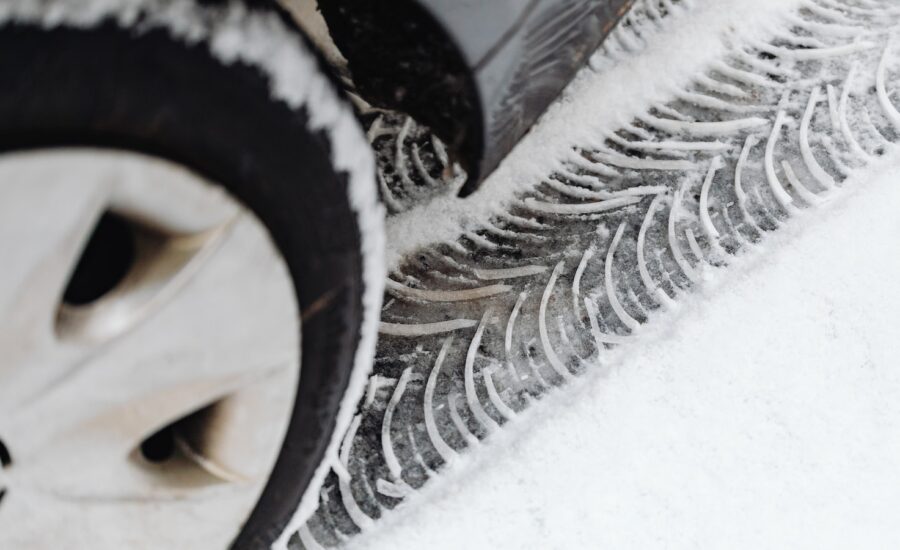Your guide to buying winter tires in Canada
What should you look for in a winter tire? Do you need winter tires at all? An auto expert answers these questions and more.
Advertisement
What should you look for in a winter tire? Do you need winter tires at all? An auto expert answers these questions and more.

For countless Canadians, winter driving can mean travelling in some of the harshest road and weather conditions on Earth—up to several months a year, depending on where you live in Canada. Installing a good set of winter tires on your vehicle can make a big difference in your safety, confidence and peace of mind while you’re on the road.
In under 60 seconds, get matched with a personalized list of loan providers based on your needs and approval likelihood. No SIN required.
Whether you’re a first-time or seasoned winter tire shopper, you’ll face a nearly daunting level of selection, price points and features, when it comes time to equip your ride for the coldest months of the year. Let’s take a close look at some of the choices you’ll face, as well as some tips and considerations to help you make a better purchase decision.
And for anyone who’s still on the fence about whether they need winter tires, we’ll explain why there’s really no substitute for the real thing.
Winter tires are specifically designed for use in the nastiest winter conditions Canadian motorists will face, and they typically last five to eight winters, though exceptions and exclusions apply. Winter tires are sometimes referred to as “snow tires,” but this title is a little reductive and only tells part of the story.
The rate at which your winter tires wear out is a function of many variables that include driver habits, maintenance habits, locale, road conditions, temperature, weather conditions and how promptly you remove winter tires after the season has ended.
In under 60 seconds, get matched with a personalized list of loan providers based on your needs and approval likelihood. No SIN required.
Remember, using winter tires in warm temperatures can accelerate tire wear, reducing the lifespan of the tires and costing you money.
When tires are installed, maintained and cared for as directed in their owner’s manual, drivers can expect a set of quality winter tires to last several years or more.
Tackling snow is a major part of winter driving in Canada, but snow is far from the only challenge winter has in store for your tires. Ice is another, as are rapidly fluctuating temperatures and road conditions, especially at times of the year when winter borders on fall and spring.
The extreme cold of Canadian winters is another major challenge for regular tires. Cold temperatures stiffen the rubber, negatively affecting the tires’ ability to grip the road. Even on dry pavement, all-season or all-weather tires can struggle to deliver acceptable grip and stopping power, since their rubber compound is not optimized for maximum performance while frozen solid.
Dedicated winter tires, by way of their tread design, rubber compound and specialized features, are carefully engineered for maximum performance and stability on snow and ice, and in cold and fluctuating winter temperatures. Winter tires also give your vehicle’s all-wheel drive (AWD) system and traction-enhancing features more grip to work with.
Whether winter in your locale tends to be very snowy, very icy, very cold or some combination of the three, a set of dedicated winter tires is your best means of enhancing safety on the road.
Fortunately, it seems that more and more drivers are taking advantage of these tires, switching from all-weather or all-season options in favour of added grip and control on snow and ice. According to a survey conducted by the Tire and Rubber Association of Canada in October 2021, nearly 70% of Canadians who drive passenger vehicles and light trucks switch to dedicated winter tires in the colder months—up from 65% the previous year.
A variety of multi-purpose tire options have become popular with drivers across the continent, as manufacturers come up with new features and innovations. At retailers, you’ll see tires labelled “all-season,” “all-weather,” “winter” and “all-terrain.”

The tread compound (or rubber “recipe”) of an all-season tire is designed to provide grip during warmer temperatures. This makes for optimal operation during summer, fall and spring. The rubber compound on an all-season tire will stiffen up in cold weather, negatively affecting grip, performance and lengthen stopping distances. They typically last three to five years before needing replacing.
All-season tires perform best in warm to hot climates, above 7 degrees Celsius, and in dry and rainy conditions. For many drivers in locales with warm, mild winters, an all-season tire may be sufficient. For drivers in locales with the extreme winter conditions characteristic of much of Canada, there are better options. One of these is the all-weather tire.
Thanks to specially designed rubber compounds that perform better in the cold, as well as clever tread patterns and other design implements, all-weather tires can be considered a winter-enhanced version of an all-season tire.
With an all-weather tire, drivers can run the same set of tires year-round, even if they’ll occasionally face winter driving conditions including cool temperatures and light snowfall. If the performance of an all-weather tire is sufficient for you, you may save time and money by not having to make a seasonal tire changeover. Note, however, that all-weather tires may have a shorter lifespan than all-season tires, about three to five years instead of the eight winters.
(For more about all-season versus all-weather tires, read a detailed comparison by Carpages.ca.)
A dedicated winter tire is the ultimate solution for driving in the cold, and on snow, slush and ice. The rubber compound and tread pattern of a dedicated winter tire is designed exclusively for use in severe conditions at sub-zero temperatures, with no compromises for use in other seasons.
To sum it up: If you’ll rarely face extreme winter weather and cold temperatures, an all-season tire may be sufficient. If you’ll occasionally drive in cool temperatures and face some light snowfall and slush, an all-weather tire may be just the ticket.
If you’ll be driving on slippery roads or at sub-zero temperatures frequently in the winter months, a dedicated winter tire will give you the best performance and safety benefits, while helping various systems in your modern vehicle work better to keep you and your family safe.
All-terrain tires are popular with pickup and SUV owners, many of whom prefer to run a single tire year-round. Look for tires with the 3 Peak Mountain Snowflake (3PMSF) symbol, which indicates a minimum level of enhanced traction on snow and ice. While a dedicated winter tire is best for most Canadians, a 3PMSF-equipped all-terrain tire is designed to offer improved wintertime performance for drivers who don’t plan on making a seasonal tire changeover. These tires typically last around six years or so.
If you’ve narrowed your options down to dedicated winter tires, you still have a few decisions to make. The options on winter tires are numerous and far-reaching, and manufacturers typically roll out one or more signature technologies to help deliver maximum performance.
Some winter tires contain crushed walnut shells for a more aggressive bite on ice. Others use micro-pores to draw water away from the road surface as the tire rolls over it, creating a better grip. Other winter tires use specialized tread patterns, rubber compounds or structural reinforcements to achieve various performance targets. These features are often proprietary and used in conjunction with other specific designs and engineering.
When considering a dedicated winter tire, be sure to understand the features it uses to optimize winter grip, and what those features mean for the performance of your vehicle in the conditions you drive it in. A qualified retailer can help you to better understand these features and how they’ll affect your driving.
While shopping around for your first set of winter tires, you’ll find that friends, family or vehicle-owner groups on Facebook or Reddit have recommendations. Experienced owners are happy to share their successes, failures and winter tires of choice. Remember that when it comes to tires, you get what you pay for. Avoid unfamiliar, extremely low-cost brands.
Many winter tires are also available with value-adding features like roadside assistance, hazard protection and specialized warranty coverage. Determine your budget, as well as the importance of these value-adding features, as you make a purchase decision.
The winter tires you’re considering may be available with factory-installed studs, or they may have a “studdable” design to which metal studs can be added before installation. Though some experts report that studded tire use is on the decline, they remain popular in some locales, especially where ice is a common part of the winter driving experience.
After nearly 20 years of testing winter tires in Northern Ontario, I choose to run a non-studded winter tire on my vehicles. For where and how I drive, I don’t find the added cost and noise of studded tires to be worth the benefits. Your results may vary.
Winter tire prices vary vastly depending on the brand of tire, the performance level, the size of the tire, and the application it’s used for. The bigger the wheels on your vehicle, the larger its tires—and its winter tire costs. Winter tires should always be installed in sets of four. If you drive a small car, a low-end set of winter tires might cost you $500, while a mid-grade set may run $700 to $800. High-end winter tires from the most popular brands can push the price closer to $900 or $1,000, though most tire manufacturers offer various winter tire options across a wide range of price points.
If you drive a pickup or SUV, or a high-performing car or coupe that requires more specialized winter tires, the price can easily double. The gist? If you drive a small car or crossover, plan to spend around $800 or $900 on a quality set of winter tires, with that figure climbing well past $1,000 if you go for a top-line tire or a tire in a larger size.
Use caution when selecting a low-cost winter tire. Some brands offer cheap winter tire options that are knock-off copies of more popular tires, and these may not utilize the same tread compound and engineering found in pricier alternatives. You get what you pay for, so buyer beware.
Unsure of how much to spend? Here’s my best bit of advice: Provided you avoid the lowest-cost winter tire options and stick to a reputable brand, you’ll likely find that switching from an all-season tire to a reputable winter tire makes a much bigger difference in wintertime traction than switching from a $150 winter tire to a $200 winter tire.
“Tires for all budgets are available,” says Alka Darichuk, owner of OK Tire Jagare Ridge in Edmonton. “That said, a first-time shopper looking for a set of 225/65R17 size tires should plan to spend between $900 and $1,200 for reputable and quality-brand tires. For example, Toyo Observe GSI6 and G3 ICE models are the most popular in Edmonton.”
Now that you know how much it can cost to buy winter tires, what about how much it can save you? Some drivers use all-season tires year-round to avoid paying for dedicated winter tires, but all-season tires need replacing every three to five years. “The most popular tire size sold in Canada is 225/65R17, which for an all-season tire would be in the $625 to $810 price range,” says Martin Gendron, general manager at tire retailer Blackcircles.ca.
If you use winter tires and switch them out each spring, you can double the life of your all-season set. Plus, by using dedicated winter tires, ultimately you’ll avoid the costs of cold-weather driving accidents due to poor tire performance, including increased insurance premiums. Speaking of which, having winter tires may get you an insurance discount—let your provider know that you use them.

Apply for a personal loan with a 8.99% to 29.49% APR. Plus, 100% online application and no early repayment fees.

Apply for a personal loan with a 9.99% to 34.95% APR. Plus, fast e-transfers and no hit to your credit score when you apply.

Pre-qualify instantly to borrow up to $35,000, with rates from 8.99%
According to Darichuk, “The best time to buy winter tires is during the fall, when most tire manufacturers have promotions. Rebates vary between $40 to $100 on select sets of four tires, depending on the manufacturer. They start as early as September 15th until mid-December.”
Don’t wait until the first snowfall to buy tires. Darichuk advises switching to winter tires when the temperature is consistently seven degrees Celsius or below. “Although only British Columbia and Quebec have mandatory winter tire laws, other provinces recommend it, and some even offer incentives,” she says. “Winter weather comes unexpectedly, and you don’t want to be too late. Avoid long wait times and book your appointment ahead. OK Tire offers convenient tire storage. This is an excellent option to save space and ensure you get the most out of your tires while keeping them in good shape.”
Keeping your tires in good shape reduces waste and saves you money in the long term. As a bonus, healthy tires tend to be more fuel-efficient, too.
To keep your winter tires in good shape while they’re in use, check and adjust inflation pressure regularly, especially in the “shoulder months,” when temperatures fluctuate more. Properly inflated tires suffer less wear and tear, handle and ride better, perform better, achieve better fuel mileage and (importantly) last longer.
Rotate your tires as outlined in the owner’s literature, as this helps ensure more uniform wear. Note that use of winter tires in warmer temperatures can rapidly accelerate wear, so remove them once spring has arrived in full.
Proper storage can help your winter tires last longer, too. Whether you’ll take advantage of seasonal tire storage at a retailer or store your winter tires at home, remember that minimizing their exposure to air and light is a great way to fend off premature tire degradation.
After removing my vehicles’ winter tires (my preferred picks are Nokian Hakkapeliitta R3s and Michelin X-Ice XI3s), I always store them in garbage bags and keep them in my dark, cool garage—ready for next year.
Share this article Share on Facebook Share on Twitter Share on Linkedin Share on Reddit Share on Email